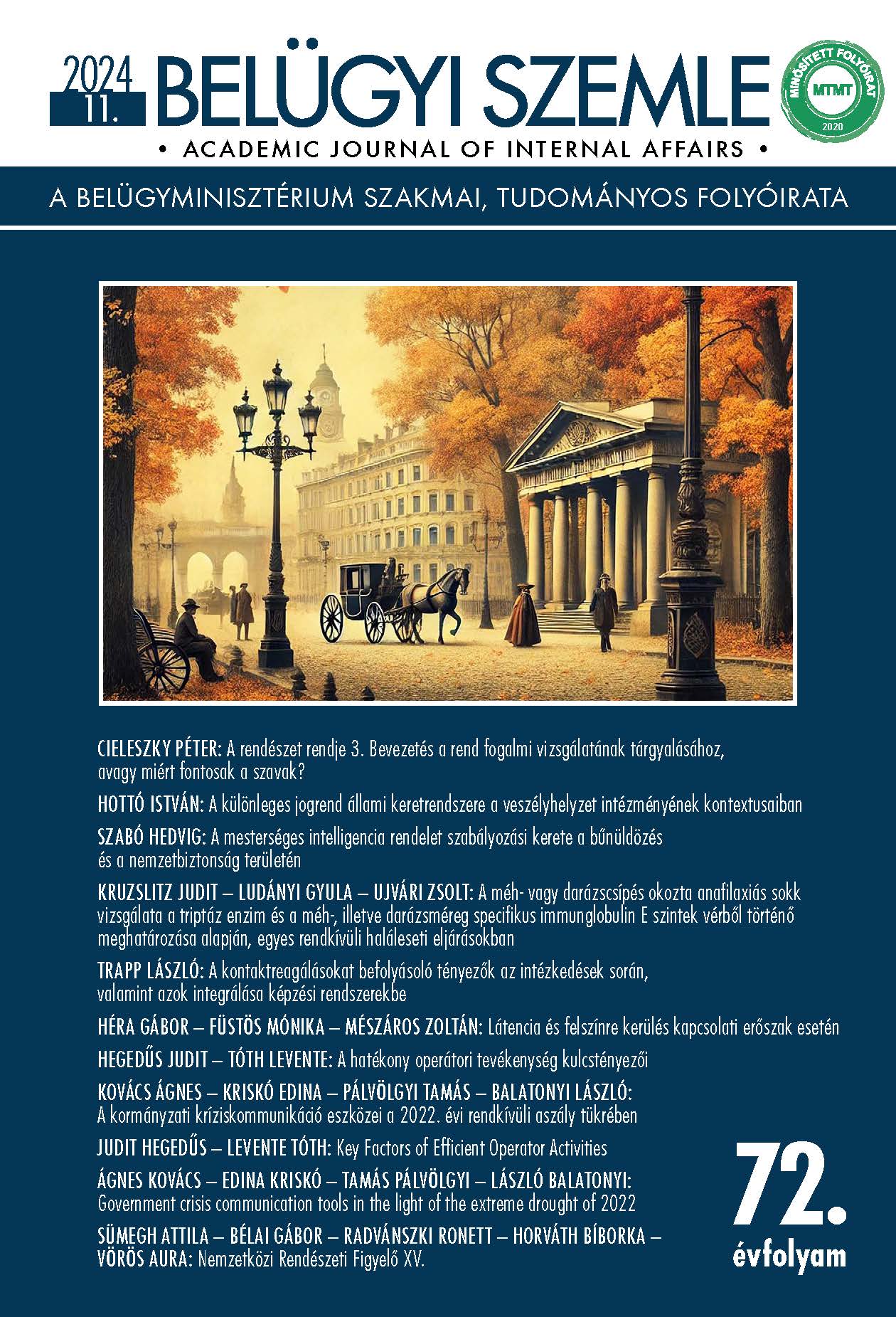Absztrakt
Cél: A tanulmány elkészítésének célja az emberi tényezők és kognitív folyamatok szerepének és jelentőségének feltárása a térfigyelő rendszerek operátori tevékenységében.
Módszertan: A szerzők különböző kutatási tanulmányokból és szabványokból merített észrevételekkel tárgyalják a hatékony videómegfigyeléshez kapcsolódó fontos emberi tényezőket, valamint a hatékony munkavégzéshez szükséges környezeti feltételeket.
Megállapítások: Az operátori tevékenység minőségét erőteljesen befolyásolják az operátor érzékelési, észlelési és figyelmi képességei. A térfigyelő rendszerek hatékony működtetése nagymértékben függ az operátorok intuíciójától, szakértelmétől és a megfelelő munkakörnyezettől.
Érték: A tanulmány hozzájárul ahhoz, hogy jobban megértsük a térfigyelő rendszerek emberi tényezőinek szerepét, és olyan irányelveket, ajánlásokat fogalmazhatunk meg, amelyek javíthatják a rendszerek operátori tevékenységének hatékonyságát.
Hivatkozások
Ankrum, D. R. (1996). Viewing distance at computer workstations. Workplace Ergonomics, 2(5), 10–12.
Ardito, M., Gunetti, M. & Visca, M. (1996). Influence of display parameters on perceived HDTV quality. IEEE Transactions on Consumer Electronics, 42(1), 145–155. https://doi.org/10.1109/30.485473
Banz, B. C., Wu, J., Crowley, M. J., Potenza, M. N. & Mayes, L. C. (2016). Gender-related Differences in Inhibitory Control and Sustained Attention among Adolescents with Prenatal Cocaine Exposure. The Yale journal of biology and medicine, 89(2), 143–151.
Blatter, K., Graw, P., Mirjam, M., Knoblauch, V., Wirz-Justice, A. & Cajochen, C. (2006). Gender and age differences in psychomotor vigilance performance under differential sleep pressure conditions. Behavioural Brain Research, 168(2), 312–317. https://doi.org/10.1016/j.bbr.2005.11.018
Chan, R. C. (2001). A further study on the sustained attention response to task (SART): the effect of age, gender and education. Brain Injury, 15(9), 819–829. https://doi.org/10.1080/02699050110034325
Csépe V., Győri M. & Ragó A. (2007). Általános pszichológia 1– 3 [General Psychology 1-3]. Osiris.
Debreczeni G. D. (2012). Videojátékok képességfejlesztő hatása (3.) [The cognitive benefits of playing video games]. Tanító 50(1), 25–26.
Diamond, A. & Lee, K. (2011). Interventions Shown to Aid Executive Function Development in Children 4 to 12 Years Old. Science, 333(6045), 959–964. https://doi.org/10.1126/science.1204529
Dúll A. (2001). Az érzékelés és az észlelés. In Oláh A. & Bugán A. (Szerk.), Fejezetek a pszichológia alapterületeiből (pp. 37–65). ELTE Eötvös Kiadó.
Enoch, J. M. (1959). Effect of the Size of a Complex Display upon Visual Search. Journal of the Optical Society of America, 49(3), 280–286. https://doi.org/10.1364/JOSA.49.000280
Fan, J., Wu, Y., Fossella, J. A. & Posner, M. I. (2001). Assessing the heritability of attentional networks. BMC Neuroscience, 2(14). https://doi.org/10.1186/1471-2202-2-14
Hannon, E. M. & Richards, A. (2010). Is inattentional blindness related to individual differences in visual working memory capacity or executive control functioning? Perception, 39(3), 309–319. https://doi.org/10.1068/p6379
Hawes, B. K., Brunyé, T. T., Mahoney, C. R., Sullivan, J. M. & Aall, C. D. (2012). Effects of four workplace lighting technologies on perception, cognition and affective state. International Journal of Industrial Ergonomics, 42(1), 122–128. https://doi.org/10.1016/j.ergon.2011.09.004
Innes, M. (2003). Understanding Social Control: Deviance, crime and social order. Open University Press.
Johnson, J. (2014). Designing with the Mind in Mind. Elsevier.
Mack, A. & Rock, I. (1998). Inattentional blindness. MIT Press. https://doi.org/10.7551/mitpress/3707.001.0001
Makeig, S., Jung, T.-P. & Sejnowski, T. J. (2000). Awareness during drowsiness: Dynamics and electrophysiological correlates. Canadian Journal of Experimental Psychology, 54(4), 266–273. https://doi.org/10.1037/h0087346
McVey, G. F. (1970). Television: Some Viewer-Display Considerations. AV Communication Review, 18(3), 277–290.
Memmert, D., Simons, D. J. & Grimme, T. (2009). The relationship between visual attention and expertise in sports. Psychology of Sport and Exercise, 10(1), 146–151. https://doi.org/10.1016/j.psychsport.2008.06.002
Meyer, D. E. & Kornblum, S. (Eds.). (1993). Attention and Performance XIV. MIT Press. https://doi.org/10.7551/mitpress/1477.001.0001
Narita, N., Kanazawa, M. & Okano, F. (2001). Optimum Screen Size and Viewing Distance for Viewing Ultra High-Definition and Wide-Screen Images. Journal of The Institute of Image Information and Television Engineers, 55(5), 773–780. https://doi.org/10.3169/itej.55.773
Neisser, U. & Becklen, R. (1975). Selective looking: Attending to visually specified events. Cognitive Psychology, 7(4), 480–494. https://doi.org/10.1016/0010-0285(75)90019-5
Norris, C. (2002). From personal to digital: CCTV, the panopticon, and the technological mediation of suspicion and social control. In Lyon, D. (Ed.), Surveillance as Social Sorting (pp. 249-281). Routledge.
Pashler, H. (1999). The Psychology of Attention. MIT Press.
Pheasant, S. (2003). Bodyspace: Anthropometry, Ergonomics and the Design of the Work (2 ed.). Taylor & Francis. https://doi.org/10.1201/9781482272420
Posner, M. I. & Marin, O. S. (Eds.). (2016). Attention and Perfomance. Routledge. https://doi.org/10.4324/9781315630236
Quintana, L., Lizarazo, C., Bernal, O., Cordoba, J., Arias, C., Cotrino, C. & Montoya, O. (2012). Control centers design for ergonomics and safety. Work, 41(1), 3164–3174. https://doi.org/10.3233/WOR-2012-0578-3164
Richards, J. E. (Ed.). (1998). Cognitive Neuroscience of Attention. Psychology Press. https://doi.org/10.4324/9781410603906
Sakamoto, K., Aoyama, S., Asahara, S., Yamashita, K. & Okada, A. (2008). Relationship between Viewing Distance and Visual Fatigue in Relation to Feeling of Involvement. In Shin, C. I. (Ed.), Lecture Notes in Computer Science (Vol. 5068, pp. 232–239). Springer. https://doi.org/10.1007/978-3-540-70585-7_26
Seppänen, O., Fisk, W. J. & Lei-Gomez, Q. (2006). Effect of temperature on task performance in office environment. 5th International Conference on Cold Climate Heating.
Stainer, M. J., Scott-Brown, K. C. & Tatler, B. W. (2013). Looking for trouble: a description of oculomotor search strategies during live CCTV operation. Frontiers in Human Neuroscience, 7(615). https://doi.org/10.3389/fnhum.2013.00615
Stainer, M. J., Scott-Brown, K. S. & Tatler, B. W. (2017). On the Factors Causing Processing Difficulty of Multiple-Scene Displays. i-Perception, 8(2). https://doi.org/10.1177/2041669516689572
Tickner, A. H., Poulton, E. C., Copeman, A. K. & Simmonds, D. C. (1972). Monitoring 16 Television Screens Showing Little Movement. Ergonomics, 15(3), 279–291. https://doi.org/10.1080/00140137208924430
Tóth A. (2023). A magánbiztonsági vállalkozások minősítési szempontrendszerének kialakítása Magyarországon. Belügyi Szemle, 71(6), 1001–1021. https://doi.org/10.38146/BSZ.2023.6.4.
Tóth L. (2005). CCTV magyarul. BM Nyomda.
Treisman, A. & Geffen, G. (1967). Selective Attention: Perception or Response? Quarterly Journal of Experimental Psychology, 19(1), 1–17. https://doi.org/10.1080/14640746708400062
Wadsworth, R. H. (1968). The practical considerations in designing audio-visual facilities. Architectural record, 144, 149–160.
Wogalter, M. S., Conzola, V. C. & Smith-Jackson, T. L. (2002). Research-based guidelines for warning design and evaluation. Applied Ergonomics, 33(3), 219–230. https://doi.org/10.1016/s0003-6870(02)00009-1
Yuan, J., He, Y., Qinglin, Z., Chen, A. & Li, H. (2008). Gender differences in behavioral inhibitory control: ERP evidence from a two-choice oddball task. Psychophysiology, 45(6), 986–993. https://doi.org/10.1111/j.1469-8986.2008.00693.x
Zimbardo, P., Johnson, R. L. & McCann, V. (2012). Psychology: Core Concepts (7 ed.). Pearson.

This work is licensed under a Creative Commons Attribution-NonCommercial-NoDerivatives 4.0 International License.
Copyright (c) 2024 Belügyi Szemle

